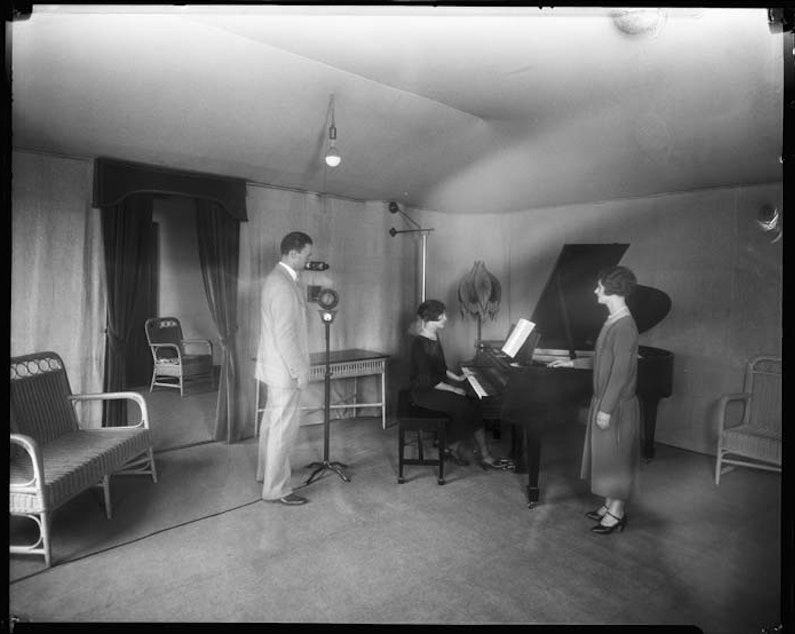The Golden Years Of Radio In Seattle

It’s been more than 60 years since KUOW first went on the air in Seattle, but local radio history goes back a bit further than that. In the first installment of a three part series, Feliks Banel has the story of what radio sounded like around here in the years before KUOW.
By 1920, transmission of the human voice by radio had become commonplace. World War I was over. The economy was starting to boom. Thousands of amateurs and experimenters were building and using their own radio transmitters and receivers to talk to each other.
It was around this time that the idea of radio broadcasting — creating programs for an audience rather than just talking to one other person — caught on with the American public.
One November night in 1920, a radio station in Pennsylvania broadcast what many consider to be the earliest radio program in American media history. It was station KDKA in Pittsburgh, in partnership with a local newspaper. They were announcing the results of the 1920 presidential election.
In many cities around the US, department stores and newspapers were the earliest radio station operators.
Sponsored
Department store owners figured that by broadcasting entertainment programs, it would encourage people to come in and buy radios, and the department store would make money. Around Seattle, one of the earliest stations was in the old Rhodes Department store, where the Seattle Art Museum now stands. KFOA entertained shoppers and listeners at home with music, drama and other performances from a special auditorium in the store.
Newspaper publishers saw radio as a logical extension of print journalism and a great way to promote themselves and sell more papers. The Seattle Post-Intelligencer built a tiny radio station on the roof of its old building at Sixth and Pike across from what’s now Nordstrom.
The late Tom Sandry was born in Seattle in 1915 and he was a radio nut. Tom loved to stay up long into the night back in the 1920s tuning in local stations like KOMO. Meanwhile, the guy next door was tuning in stations from far away and making sure Tom knew all about it.
In an interview from 2004, Tom described his long-ago neighbor’s radio-boasting: “Your neighbor might be bragging to you anytime. ‘Well, Tom, while you guys were listening to Seattle broadcasts, I had KPO San Francisco on my set.”
Tom also witnessed one of the earliest radio broadcasts in Seattle history. He went to that tiny Post-Intelligencer radio station in the summer of 1921 to watch his father’s quartet broadcast live from the primitive rooftop studio.
Sponsored
“The engineer was fiddling with dials and these things were popping and cracking,” Tom said. “And finally they settled down, and in the middle of the room was a giant megaphone hanging from the ceiling.”
What Tom saw was radio at its most local, when there were no national broadcast networks. But less than a decade later, special AT&T wires reached Seattle from New York, and KOMO became an affiliate of NBC, the National Broadcasting Company. It was then that radio became a serious nationwide business and took a decidedly commercial turn.
Seattle listeners could now tune to a local station and hear the same national programs (and same national commercials) that people all over the US could hear, like Bob Hope and his Pepsodent Toothpaste program, appearing live at Fort Lewis during World War II.
“Seattle is a wonderful city,” Hope told the audience of Fort Lewis soldiers. “It’s really a boomtown now with all the defense industries, shipyards here. But boy, is it crowded. I stopped one guy on the street and I said, ‘How do I get a room here?’ and he said, ‘I don't know. I’m the mayor and I live in Tacoma.’”
In the booming economy after World War II, social critics worried that broadcasting had become too commercial. Some said that there needed to be more focus on education and culture, and less focus on things like toothpaste. Around the same time, FM radio technology became practical. So the government set aside part of the FM dial for non-commercial and educational radio stations.
Sponsored
The University of Washington’s non-commercial radio station went on the air in January 1952.
In those early years on KUOW, there were roundtable discussions, educational programs and classical music. But that was the easy part. Just ahead lay the rise of television, the dawn of the on-air pledge drive and a host of other challenges to what’s now called public radio.
But getting KUOW on the air was the easy part.
I’m Feliks Banel for KUOW.
